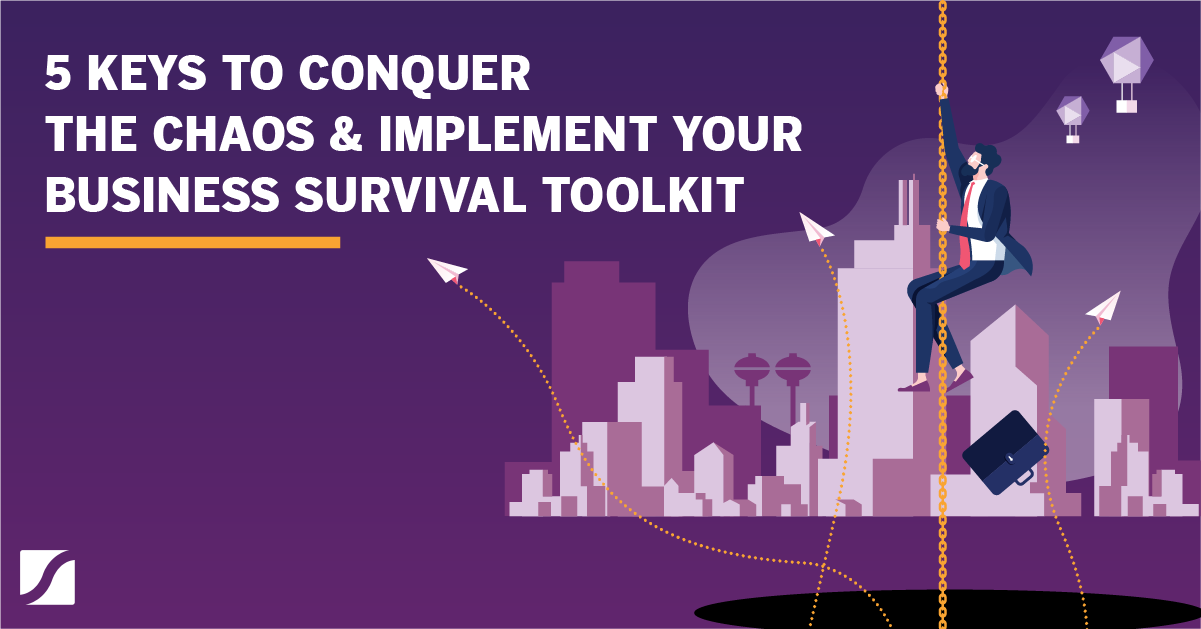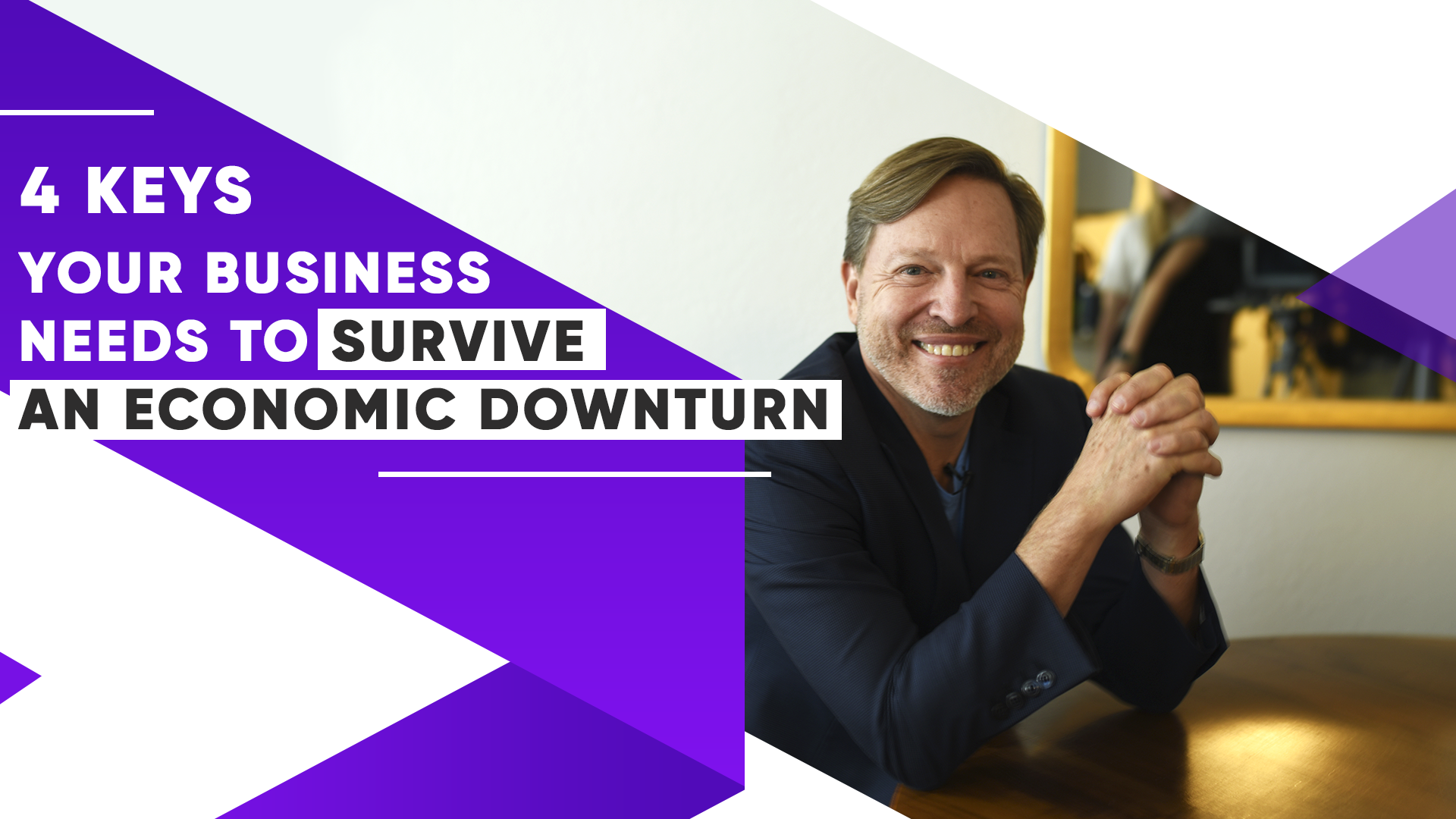The 4 Decisions You Need To Scale Your Startup (with Proof!)

For any startup or mid-market company that wants to scale, they need to nail four key decisions to get to their next level of growth.
What are these four decisions, and more importantly, what kind of real-world results can they give you?
In a recent webinar on the Scaling Up methodology, I went deep into these four key decisions. However, this time I wanted to share some Proof that focusing on these 4 things are, in fact, the key to scaling up.
To demonstrate how real business leaders apply this framework to grow their business, I invited the co-founder and CEO of Proof, Dave Rogenmoser to join me on the online training.
Proof is the world’s first social proof marketing platform. Their software helps you increase conversion rates on your website by displaying recent customer activity as social proof.
The entire company was built on the foundations of the Scaling Up methodology, so I was really excited to have Dave join me.
In case you missed the live online training, this article recaps the key takeaways covered. Throughout the article, you’ll find sections called “In Dave’s Own Words…”, where Dave shared his own real-world personal experience based on the principles I shared.
Stop Being a Slave to Your Business
Are you familiar with exhaustion and burnout? You’re not alone. Many entrepreneurs, founders, and business leaders know all too well the cycle of exhaustion and burnout that seemingly goes hand in hand with growing a company.
The Scaling Up methodology tackles these issues by providing you with a framework that allows you to scale while reducing drama. It’s really exciting to see how the same principles that worked three decades ago still work today for companies around the world. In fact, I’ve just gotten back from China, where my Scaling Up book has been translated into Simplified Chinese to reach a further audience there. The reason why these principles have stood the test of time and can cross borders is what lies at its core.
The core principle of the Scaling Up methodology is: “Routines will set you free”. Now that might seem counterintuitive, but structures and discipline allow you to streamline operations and reduce the drama that comes with the complexities of growth. This gives you the time to grow a business that supports your freedom.
In Dave's Own Words...
About three years ago today, I sat down with my co-founders. At the time, we were running this other information marketing business. We were so exhausted and worn out. Dealing with the daily complexities would just drain so much emotion. 
We decided we didn’t want to keep going like this anymore. So when we started Proof, we thought we would try out building it using the Scale Up methodology.
At first, I thought it was very corporate. I thought, “We’re a startup. Why should we have structure or meetings? We want to be free from all of that.”
However, not having that structure had led us to become slaves to our business. So we began applying the methodology.
The result? With more predictability in our day, we felt way less stressed than we ever had before. Our employees were happier because they actually knew what was in my head. And everybody just felt a lot more confident.
Without doubt, the Scaling Up methodology has played a huge part in how we successfully launched Proof. It has been a big game changer for us.
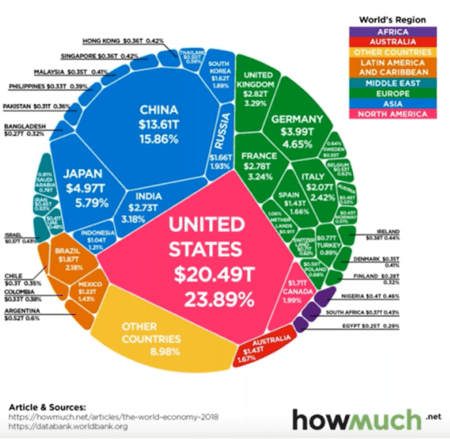 When you have day-to-day freedom in your company instead of being chained to drama and firefighting, you get to focus on growing your impact and tapping into the global market.
When you have day-to-day freedom in your company instead of being chained to drama and firefighting, you get to focus on growing your impact and tapping into the global market.
This graph shows the size of the world economy in 2018. It’s grown from $34 trillion at the turn of the century to $88 trillion this year.
That’s a lot of pie to slice into!
This is the freedom and market potential that the Scaling Up methodology can bring. But it takes serious work and discipline. Let’s explore the three disciplines that act as prerequisites of the Scaling Up methodology.
3 Disciplines of the Scaling Up Methodology
The three disciplines of the Scaling Up methodology are:
-
Priorities
Having clarity on your #1 daily, monthly, quarterly, and yearly priorities. It's best for this decision to be based on real data, both quantitative and more importantly qualitative data. -
Data Metrics
Having data and metrics give you clarity and foresight to make important decisions, from strategy to execution. -
Meeting Rhythms
Establishing meeting rhythms is one of the 10 Rockefeller Habits which create the kind of discipline that leads to freedom. Meeting rhythms include the daily huddle, weekly meetings, and quarterly and annual strategic meetings.
Establishing these three disciplines as values everyone in the company lives by will give you the first ingredients you need to take your company from good to great, which Jim Collin’s coined as disciplined people, disciplined thought, and disciplined action.
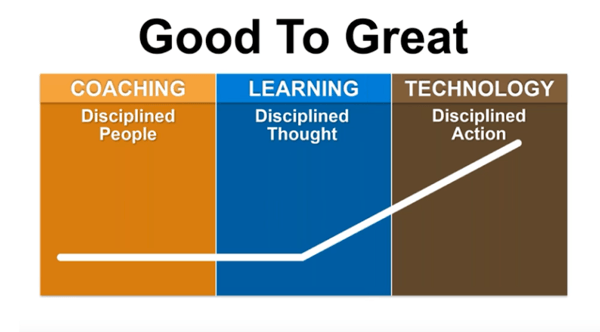
The Missing Ingredient
To excel in these three decisions, leaders of an organization must make the right decisions for each discipline as follows.
- Achieving “disciplined people” require decisions around “People”
- Achieving “disciplined thought” require decisions around “Strategy”
- Achieving “disciplined action” require decisions around “Execution”
While these three decisions will help your company go from good to great, it still won’t be enough to scale a company. Why? Because you also need cash.
Simply put, growth sucks cash. And that’s why the fourth decision every leader needs to make for their company to scale is around “Cash”.
The Scaling Up methodology has effectively been built around these four decisions needed for growth: People, Strategy, Execution & Cash.
Next, we’ll go into the tools that will help you make the right decisions for each one.
Scaling Up Tools for “People”
What key decisions do you need to make about the people you interact with? In this section, we’re going to explore two different tools to guide you.
Tool #1: FACe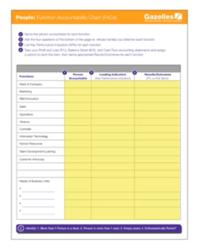
How can you figure out if you have the right people in your company?
We have a tool called the Function Accountability Chart (FACe) to help you make that decision.
This tool will give you clarity on how every facet of your business has a person in the organization assigned with the responsibility to ensure goals are met.
In Dave's own words...
It was really great to have all the decisions we needed to make listed out like this. We just started filling in the FACe tool and it really helped us not just gain clarity on our responsibility, but how we can put our best talents to use.
I could turn to my two other co-founders and say, “Listen, I need to share some of the load with you. You’re qualified here, so you can take some of this stuff on my plate.”
This tool also helped us realize some of the gaps we had. For example, we didn't have anybody to do treasury. Nobody thought about that. So we left those blank at first and made a point that it needs to be a top priority when we hire.
The other thing I like about the FACe tool is how it empowered people. Once you see your name next to your responsibility, you become empowered and dedicated. You also gain clarity on what you need to do every day.
Overall, this definitely gave us a lot of clarity and pointed out the holes in our organization.
.
Tool #2: Top 25 Influencers
The people decisions you make will not be limited to the people within your company. To scale faster, you also need to develop relationships with key people. Who are the key players in your industry? Write down your top 25, or more. Your selection criteria should be the people or brands who will be impacted by the vision you aspire to achieve.
The biggest indicator of your company’s success is how many dinners, coffee chats, and breakfasts you have with the people on your list. That’s what it takes to build those relationships.
When I followed these steps for EO, we became a global organization within 36 months. We even got President Reagan, who was one of the influencers I had on my list, to deliver a speech on the importance of entrepreneurs in our 1986 convention in Los Angeles.
In Dave's Own Words...
We did the exact same thing where we listed the biggest names in the marketing space. We knew that if they used our product, then everyone else will see our products.
Now, I didn't know any of them personally. But I knew a few people who knew all of them. So we invited them to be our formal advisors in exchange for a little bit of equity. Then, I showed them my list and said, “I need you to connect me to these 50 people here.”
They got to work and within three to four months, we probably had 45 of the 50 people on our list using Proof. It was just awesome.
Scaling Up Tools for "Strategy"
Everyone knows strategy is important, but how do you discern between a flash-in-the-pan strategy and one that will stand the test of time? Check out these two tools you can use to generate a powerful strategy.
Tool #1: Own the Words
When I was in China last week, I asked this question to the people at my workshops: “What company comes to mind when I say the words ‘pizza delivery in 30 minutes or less, or your next pizza is free’?” Without fail, they would answer, “Dominos”.
This is the power of being able to state a strategy simply. Not only do people remember your brand, but your brand also owns the words.
Like Dominos, the words your brand owns will be largely linked to your brand promise. The more your promise makes things easier for your customers, the better. Here are a few more examples of brands who owns the words of their brand promise in their niche:
- Ikea: Flat-packed
- FastCat: FerrySafe, FerryConvenient, FerryFast
- Amazon: One-Click Easy
In Dave's Own Words...
In Dave's Own Words...
First, we asked ourselves what would our brand promise be? We decided our promise would be better conversions. And we backed up our promise with a 14-day guarantee.
Based on this, we created a 14-day trial. If our customers don’t achieve better conversions within that period, then they don’t have to pay. This really got us to focus on the right customers.
Next, we had to focus on making it easy. If it took our customers 11 days to set it up, then they would only have three days left on their trial. They’d get frustrated and cancel.
So we came up with two specific KPIs to live up to this brand promise: one around the average increase of customer conversion rate, and the second around the time to self-install.
Today, our Proof tool is the highest converting and easiest to implement in our niche. Determining our KPIs and clarity of our brand promise early on was a huge part of our successful strategy..
Tool #2: 7 Strata of Strategy
How can you come up with a powerful strategy? One of the key tools of the Scaling Up methodology is called the 7 Strata of Strategy.
The components of the 7 Strata of Strategy, when done right, will together ensure you stand out in the market, crush the competition, and achieve top-line revenue growth as a market leader.
In Dave's Own Words...
In Dave's Own Words...
If there's any tool you use and take away from this training, it would be 7 Strata of Strategy. There are some really hard questions that can get kind of uncomfortable.
Many of the questions were not easy for us to answer at the beginning. That forced us to sit down and wrestle through the really tough questions you have to answer to become a big company.
So I really love this tool. It helped us determine that the word we want to own is “social proof”. And at the time, social proof marketing was a category that didn’t really exist. So we said, “Let’s go own that”.
Fast forward two years later and I was talking to a prospect when they said, “I was looking for social proof marketing tools.” I just laughed. Because that wasn’t even a thing two years ago!
Scaling Up Tools for “Execution”
When it comes to implementing with surefire execution that allows you to scale, I stand by the 10 Rockefeller Habits. This is what gives you relentless repeatability. What these habits boil down to is focus and discipline. As I like to say it, routine sets you free. Here are the 10 habits.
Tool #1: 10 Rockefeller Habits
- Healthy Team
- Alignment to #1 Thing
- Meeting Rhythms
- Clear Accountabilities
- Employee Feedback
- Customer Feedback
- Values & Purpose Alive
- Articulate the Strategy
- Know a Great Day/Week
- Plans & Performance Visible
In Dave's Own Words...
To be honest, the 10 Rockefeller Habits checklist is one of the tools that I didn't really know if we needed at first. I kept putting it off until one day, I thought I’d just show it to the team. They immediately said they wanted to implement this. They saw a need for it.
So we decided to look through and pick one habit to focus on every quarter. We printed it out on a poster, put it up on the wall and announced, “This is our core focus.''
I think it was easier for us to do it that way. It can be a little intimidating thing to look at all 10. But just like sawing wood, we just kept going and kept knocking them off one by one every quarter.
It was good to really nail each habit before moving on to the next one. It just brought so much alignment to the company and everybody got really excited. Everyone felt like they could operate a lot more effectively.
Scaling Up Tools for “Cash”
Don’t fall into the false belief that startups require venture capital in order to scale. Here, I share my favourite tool to generate the cash needed to scale: customer funding. Plus, I’ll give a quick overview of the CASh tool to manage your cash effectively.
Tool #1: Customer-Funded Business
Growth sucks cash. In order to scale, you need cash.
John Mullins wrote a book called the “Customer-Funded Business”, and here’s a great example of how to use your customers to fund your business growth.
A father and son team recognized an important trend that people want to eat local. They noted this trend was particularly critical with honey, but it's not easy to get your own honey. That’s when they decided to invent a device called the Flow.
Their invention required 3D printing and they needed to raise $70,000 to launch their business. They could have gone to friends, family and fools, but instead they set up a campaign on a crowdfunding site.
They set a record by pre-selling $250,000 worth of this device within the first 15 minutes of launching their crowdfunding campaign. They then went to hit their first million in three hours, which then doubled in the next 11 hours. When the dust settled 30 days later, they had generated over $12 million in revenue.
Tool #2: Cash Acceleration Strategies (CASh)
 Generating cash for growth is the first step. Next, you need to manage your cash well. This is where the CASh tool comes in.
Generating cash for growth is the first step. Next, you need to manage your cash well. This is where the CASh tool comes in.
This tool helps you break down your Cash Conversion Cycle (CCC) into four components, and then brainstorm ways to increase cash flow.
We’ve had many clients double their operating cash flow immediately after working through this tool. It’s also a great exercise to do with middle managers, to strengthen their understanding of how cash flows through the organization and to illustrate how everyone can make a positive contribution to improving the CCC.
In essence, by managing the decisions around generating cash and managing cash flow, you’ll reduce the chaos caused by lack of funds when scaling up.
Summary
To wrap things up, the four strategic decisions you make around People, Strategy, Execution, and Cash is pivotal to turn your startup into a scale-up with more efficiency and freedom.
If you would like to experience the Scaling Up tools mentioned in this article — and more — check out the learning resource below.
Join Scaling Up Master Business Course
If you’re looking for extra support to implement your winning strategy to help you thrive into 2020, then now is the best time to join our revamped Scaling Up Master Business Course.
Based on the key pillars of Scaling Up, this program is designed to help your organization adopt a new strategy quickly and efficiently. All the Scaling Up tools can be studied and implemented virtually – and we’re providing extra assistance by bringing in guest speakers, more live sessions, and an even stronger community support system than before.
Now is not the time to be alone. Surviving the crisis requires us to learn and stick together. Learn more about how we will help you practically scale your business with the Scaling Up Master Business Course so you can learn how to manage chaos and get aligned to thrive this year!



